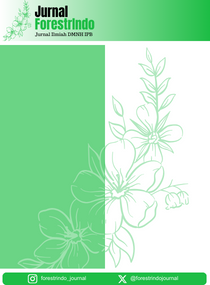PERUBAHAN KERAPATAN TUTUPAN TAJUK HUTAN MANGROVE
Abstract
Coastal development leads to environmental degradation and threatens the preservation of coastal natural resources, particularly mangrove forests. This study aims to analyze the canopy cover density and changes in mangrove forest density levels using SPOT 6 indices. The analysis of mangrove forest land cover employs digital classification methods, specifically maximum likelihood and visual analysis . Density analysis utilizes vegetation indices from SPOT 6 imagery for the years 2016, 2019, and 2022. The percentage values of canopy cover in the field are determined using the hemispherical photography method. These values are used to test the accuracy of mangrove forest density levels.The accuracy test results show an overall accuracy of 83.33% for both NDVI and SAVI indices. The NDVI index is used in analyzing changes in the extent of mangrove forest density from 2016 to 2019 to 2022, with a transformation from moderate to dense density levels covering an area of 4.327 ha (29%). From 2019 to 2022, there is a decrease in the extent of dense density areas, transforming into moderate density levels, covering an area of 6.471 ha (45%). Additionally, from 2016 to 2022, a significant change occurs, with an area of 3.754 ha (26%) transitioning from sparse to moderate density levels.
Copyright (c) 2024 Bella Febrianti, Nining Puspaningsih, Sri Rahaju

This work is licensed under a Creative Commons Attribution-ShareAlike 4.0 International License.



.svg_1.png)






